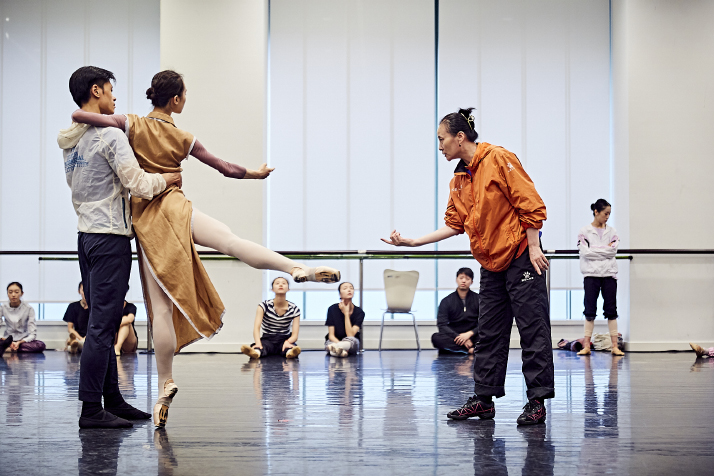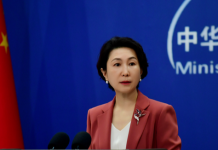
No. 1650, Hongqiao Road, Shanghai, is a special place for Xin Lili. It’s where the Shanghai Dance School and Shanghai Ballet are located, and where she has been studying and working since 1973. Around the age of 9, Xin began as a student dancer at the school before joining the Shanghai Ballet in 1979 upon graduation.
“I was somehow destined or born to do it,” Xin, now the head of the Shanghai Ballet told Beijing Review. “That is how ballet is. It’s so amazing and it seems to have its own soul. Fall in love with it, and you’ll find happiness.”
Dancer and administrator
“I’ve been dancing since I was a kid, and there hasn’t been a single day that my body hasn’t hurt. Even now, either my lower back, hips, or knees still hurt. Sometimes my ankles hurt too. It is tough. So ballet dancers must be resilient,” Xin said.
According to Xin, those who dance well are very self-disciplined. Thinking back to her days as a dancer, she remembers there was never one day that she slept in. “No matter how exhausted I was, even if I went to sleep at 3 o’clock in the morning, I would get up at 5 o’clock. There was no procrastination. Never. As soon as I told myself to get up, I got up.”
She believes developing these kinds of habits is one of the benefits she received from ballet. “I’ve always believed that a person doing things well has a lot to do with his or her life habits or mindset,” she said.
Whether as a dancer or an administrator, Xin thinks of ballet as a science. “It’s like how a seed grows into a tree, or how many cells combine and function as one. This idea also applies to ballet,” she explained, adding that dancers need to refine every single action, every chapter of a dance, and also the performance of the whole piece. How to organize it as a whole is quite important; from zero to one, they need to spare no efforts, she said.
When talking about the Shanghai Ballet, Xin looks like a mother. “I am sometimes too kind to these kids when training. But they are all really good kids.”
Regarding the merits of the Shanghai Ballet, Xin said it has many excellent dancers, such as first principal dancer Wu Husheng, first principal dancer Fan Xiaofeng and principal dancer Qi Bingxue.
“We call these top talents ‘talents on top of the spire,’ and we are strong in this regard,” Xin said, continuing that the Shanghai Ballet has top dancers in multiple age groups. “When we dance together, as a whole, we are very competitive,” Xin emphasized.
The Shanghai Ballet provides dancers of different levels with different training plans. Xin said at the core of their training is providing opportunities for them to participate in productions and gain stage experience.

Ballet communications
Chinese ballet has different dance languages from Western ballet. “We integrate folk dance, classical ballet, Chinese Opera, as well as bazigong, which means we use props,” Xin said. The female leading roles in classical ballets seldom use props, and they hold a glass at most, according to Xin.
The Shanghai Ballet has also incorporated various overseas elements to create its own style. How to make best use of elements from overseas, in particular, how to reorganize them to tell Chinese stories, is very important, Xin said.
The Shanghai Ballet has developed and improved by performing overseas and helped introduce Chinese culture and stories to new audiences.
For example, they have taken the Chinese ballet The White Haired Girl to many countries. The story, set in the 1940s, centers on the life of Xi’er, a girl born into a humble life in north China. Xi’er escapes to hide deep in mountains after her father Yang Bailao is killed by the greedy and cruel debt collector Huang Shiren. Due to her difficult circumstances and prolonged malnutrition, she loses her youthful vitality and her hair turns white. She is later saved by Communist Party of China-led forces.
“I believe all audiences can learn about Chinese culture from watching The White Haired Girl. It’s true,” Xin said.
The Shanghai Ballet has also invited international directors to direct performances of Echoes of Eternity, Jane Eyre, Hamlet, The Lady of the Camellias and The Phantom of the Opera.
“We made them into modern ballet performances and we took the works to stages overseas,” Xin said, adding that they took Jane Eyre to Britain and took Echoes of Eternity to Moscow, Russia. They also performed Swan Lake, Coppelia and Giselle in Canada, as well as staged Swan Lake in New York’s American Ballet Theatre and the Lincoln Theater.
“It was so difficult,” Xin said, recalling the time when a total of 48 “swans” went to other countries, even the birthplace of Swan Lake, to perform.
“We could not have dared to go if we hadn’t achieved a high-quality performance,” she added.
The Shanghai Ballet has the capability and confidence to not only present Chinese stories, but also rechoreograph Western ones. Once, in an interview in London, Xin was asked why the Shanghai Ballet rechoreographed Jane Eyre and then performed it in London.
“I replied that London is a megacity with an open mind and a big heart and so is Shanghai. People in Shanghai like the performance, so how could those in London not?” Xin said.
“We need to improve ourselves, and the country is encouraging cultural development and cultural confidence. We have to focus on our artistic works so as to enhance our confidence,” Xin said.
“Ballet is an art without a ceiling. It means you can always do better. That’s ballet,” Xin concluded. –The Daily Mail-Beijing Review news exchange item





